Integrated Assessment of Surface Water Quality in Danube River Chilia Branch
Abstract
:1. Introduction
2. Materials and Methods
2.1. Study Area
2.2. Chemical Analysis
2.3. Method of Evaluation of Chilia Branch Water Quality, Using the Canadian Council of Ministers of Environment Water Quality Index (CCME WQI)
2.4. Statistical Interpretation
2.5. Mapping Method for the Water Quality Parameters
3. Results and Discussion
4. Conclusions
Author Contributions
Funding
Institutional Review Board Statement
Informed Consent Statement
Data Availability Statement
Acknowledgments
Conflicts of Interest
References
- Sener, S.; Sener, E.; Davraz, A. Evaluation of water quality using water quality index (WQI) method and GIS in Aksu river (SW-Turkey). Sci. Total Environ. 2017, 584–585, 131–144. [Google Scholar] [CrossRef]
- Oz, N.; Topal, B.; Uzun, H. Prediction of water quality in Riva river watershed. Ecol. Chem. Eng. S 2019, 26, 727–742. [Google Scholar] [CrossRef] [Green Version]
- Teodorof, L.; Burada, A.; Despina, C.; Seceleanu-Odor, D.; Tudor, A.I.M.; Ibram, O.; Năvodaru, I.; Tudor, M. Integrated indices for surface water and sediment quality, according to Water Framework Directive. J. Environ. Prot. Ecol. 2016, 17, 42–52. [Google Scholar]
- Iticescu, C.; Georgescu, L.P.; Murariu, G.; Topa, C.; Timofti, M.; Pintilie, V.; Arseni, M. Lower Danube Water Quality Quantified through WQI and Multivariate Analysis. Water 2019, 11, 1305. [Google Scholar] [CrossRef] [Green Version]
- Kachroud, M.; Trolard, F.; Kefi, M.; Jebari, S.; Bourrié, G. Water Quality Indices: Challenges and application limits in the literature. Water 2019, 11, 361. [Google Scholar] [CrossRef] [Green Version]
- Chapter 10 Nutrients—Nitrogen and phosphorus from Volunteer Estuary Monitoring Manual, a Methods Manual, Second Edition, EPA-842-B-06-003. 2006. Available online: http://wwwepagov/owow/estuaries/monitor (accessed on 10 April 2021).
- Karabulut, A.; Bouraoui, F.; Grizetti, B.; Bidoglio, G.; Pistochi, A. Managing Nitrogen and Phosphorus Loads to Water Bodies: Characterisation and Solutions. In Towards Macro-Regional Integrated Nutrient Management. Joint Research Centre, JRC-Ispra; Report EUR 26822 EN; Publications Office of the European Union: Luxemburg, 2014; pp. 1–73. [Google Scholar] [CrossRef]
- Messyasz, B.; Treska, E. Benthic diatoms as valuable indicators of anthropogenic eutrophication in biomonitoring of Ribbon lake. Ecol. Chem. Eng. 2019, 26, 709–726. [Google Scholar] [CrossRef] [Green Version]
- Kanownik, W.; Policht-Latawiec, A.; Fudała, W. Nutrient pollutants in surface water—Assessing trends in drinking water resource quality for a regional city in central europe. Sustainability 2019, 11, 1988. [Google Scholar] [CrossRef] [Green Version]
- Spiridon, C.; Burada, A.; Teodorof, L.; Despina, C.; Seceleanu-Odor, D.; Tudor, M.; Ene, A. Chlorophyll a and total nutrients distribution from surface waters in Romanian MONITOX network in 2019 and 2020. Ann. Univ. Dunarea Jos Galati Fasc. II Math. Phys. Mec. Theor. 2020, 43, 184–189. [Google Scholar] [CrossRef]
- Pantelica, A.; Ene, A.; Georgescu, I.I. Instrumental neutron activation analysis of some fish species from Danube River in Romania. Microchem. J. 2012, 103, 142–147. [Google Scholar] [CrossRef]
- Galatchi, L.D.; Tudor, M. Europe as a source of pollution—The main factor for the eutrophication of the Danube Delta and Black Sea. In NATO Security through Science Series C: Environmental Security; Springer: Berlin/Heidelberg, Germany, 2007; pp. 57–63. [Google Scholar]
- Ene, A.; Denga, Y.; Bogdevich, O.; Zubcov, E. (Eds.) Atlas of Maps; Tehno Press: Iasi, Romania, 2015; ISBN 978-606-687-235-5. Available online: https://www.researchgate.net/publication/305317824_Atlas_of_Maps (accessed on 8 April 2021).
- Paun, I.; Chiriac, F.L.; Marin, N.M.; Cruceru, L.V.; Pascu, L.F.; Lehr, C.B.; Ene, C. Water Quality Index, a useful tool for evaluation of Danube River raw water. Rev. Chim. 2017, 68, 1732–1739. [Google Scholar] [CrossRef]
- Nutrients. ICPDR—International Commission for the Protection of the Danube River. Available online: http://wwwicpdrorg/main/issues/nutrients (accessed on 20 March 2021).
- Spanos, T.; Ene, A.; Xatzixristou, C.; Papaioannou, A. Assessment of groundwater quality and hydrogeological profile of Kavala area, northern Greece. Rom. J. Phys. 2015, 60, 1139–1150. [Google Scholar]
- Poonam, T.; Tanushree, B.; Sukalyan, C. Water quality indices—Important tools for water quality assessment: A review. Int. J. Adv. Chem. 2013, 1, 15–28. [Google Scholar]
- Directive 2000/60/EC of The European Parliament and of The Council of October 23rd, 2000 Establishing a Framework for Community Action in the Field of Water Policy (WFD). Off. J. L 2000, 327, 1–73. Available online: http://ec.europa.eu/environment/water/water-framework/index_en.html (accessed on 6 March 2021).
- Spanos, T.; Ene, A.; Simeonova, P. Chemometric expertise of the quality of groundwater sources for domestic use. J. Environ. Sci. Health A Tox. Hazard. Subst. Environ. Eng. 2015, 50, 1099–1107. [Google Scholar] [CrossRef]
- Sutadian, A.D.; Muttil, N.; Yilmaz, A.; Perere, B.J.C. Development of river water quality indices—A review. Environ. Monit. Assess. 2016, 188, 2–29. [Google Scholar] [CrossRef] [Green Version]
- Avigliano, E.; Schenone, N. Water quality in Atlantic rainforest mountain rivers (South America): Quality indices assessment, nutrients distribution, and consumption effect. Environ. Sci. Pollut. Res. 2016, 23, 15063–15075. [Google Scholar] [CrossRef]
- Canadian Council of Ministers of the Environment (CCME). Canadian Water Quality Guidelines for the Protection of Aquatic Life: CCME Water Quality Index 1.0; Technical Report; Canadian Council of Ministers of the Environment: Winnipeg, MB, Canada, 2001; pp. 1–5.
- Bilgin, A. Evaluation of surface water quality by using Canadian Council of Ministers of the Environment Water Quality Index (CCME WQI) method and discriminant analysis method: A case study Coruh River Basin. Environ. Monit. Assess. 2018, 190, 554. [Google Scholar] [CrossRef]
- Ismail, A.H.; Robescu, D.; Hameed, M.A. Application of CCME WQI in the assessment of the water quality of Danube River, Romania. J. Eng. Technol. 2018, 36, 142–146. [Google Scholar] [CrossRef]
- Abbasi, T.; Abbasi, S.A. Water Quality Indices; Elsevier: Amsterdam, The Netherlands, 2012; ISBN 978-0-444-54304-2. [Google Scholar]
- Lumb, A.; Sharma, T.C.; Bibeault, J.F.; Klawunn, P. A comparative study of USA and Canadian Water Quality Index models. Water Qual. Expo. Health 2011, 3, 203–216. [Google Scholar] [CrossRef]
- Ranjbar, J.A.; Masoodi, M.; Sharifiniya, M.; Riyahi, B.A. Integrated river quality management by CCME WQI as an effective tool to characterize surface water source pollution (Case study: Karun River, Iran). Pollution 2016, 2, 313–330. [Google Scholar] [CrossRef]
- Li, H.; Smith, C.D.; Wang, L.; Li, Z.; Xiong, C.; Zhang, R. Combining spatial analysis and a drinking water Quality Index to evaluate monitoring data. Int. J. Environ. Res. Public. Health. 2019, 16, 357. [Google Scholar] [CrossRef] [PubMed] [Green Version]
- SR ISO 5667-6: 2014. Water Quality Sampling. Part 6 Guidance on Sampling of Rivers and Streams. ICS: 13.060.10 Water of Natural Resources. 13.060.45 Examination of Water in General. 2014. Available online: https://www.iso.org/standard/55451.html (accessed on 23 February 2021).
- Hansen, H.P.; Koroleff, F. Determination of nutrients. In Methods of Seawater Analysis, 3rd ed.; Grasshoff, K., Kremling, K., Ehrhardt, M., Eds.; Wiley-VCH: Weinheim, Germany, 1999; pp. 159–228. [Google Scholar] [CrossRef]
- Kuss, J.; Nausch, G.; Engelke, C.; Weber, M.; Lutterbeck, H.; Naumann, M.; Waniek, J.J.; Schulz-Bull, D.E. Changes of nutrient concentrations in the western Baltic Sea in the transition between inner coastal waters and the central basins: Time Series From 1995 to 2016 With Source Analysis. Front Earth Sci. 2020, 8, 106. [Google Scholar] [CrossRef]
- Order MEWM no 161/2006 of Romanian Ministry of Environment and Water Management Regarding Norms for Surface Water Classification in Order to Establish Ecological State of Water Bodies; Romanian Official Monitor: Bucharest, Romania, 2006; Available online: http://www.legex.ro/Ordin-161-2006-71706.aspx (accessed on 10 February 2021).
- Hair, J.F.; Hult, G.T.M.; Ringle, C.M.; Sarstedt, M. A Primer on Partial Least Squares Structural Equation Modeling (PLS-SEM), 2nd ed.; Sage: Thousand Oaks, CA, USA, 2017; ISBN 987148337745. [Google Scholar]
- Fahmy, M.A.; Abbas, M.M.; Beltagy, A.I. Distribution of nutrient salts in the coastal Egyptian Mediterranean waters after 30 years of the High Dam erection. Bull. Natl. Inst. Oceanogr. Fish 1996, 22, 267–291. [Google Scholar]
- Riley, J.P.; Chester, R. Introduction to Marine Chemistry; Academic Press: London, UK; New York, NY, USA, 1971; ISBN 10: 0125887507/13: 9780125887502. [Google Scholar]
- Qadir, A.; Malik, R.N.; Husain, S.Z. Spatio-temporal variations in water quality of Nullah Aik-tributary of the river Chenab, Pakistan. Environ. Monit. Assess. 2008, 140, 43–59. [Google Scholar] [CrossRef]
- Frîncu, R.-M. Long-term trends in water quality indices in the Lower Danube and tributaries in Romania (1996–2017). Int. J. Environ. Res. Public Health 2021, 18, 1665. [Google Scholar] [CrossRef]
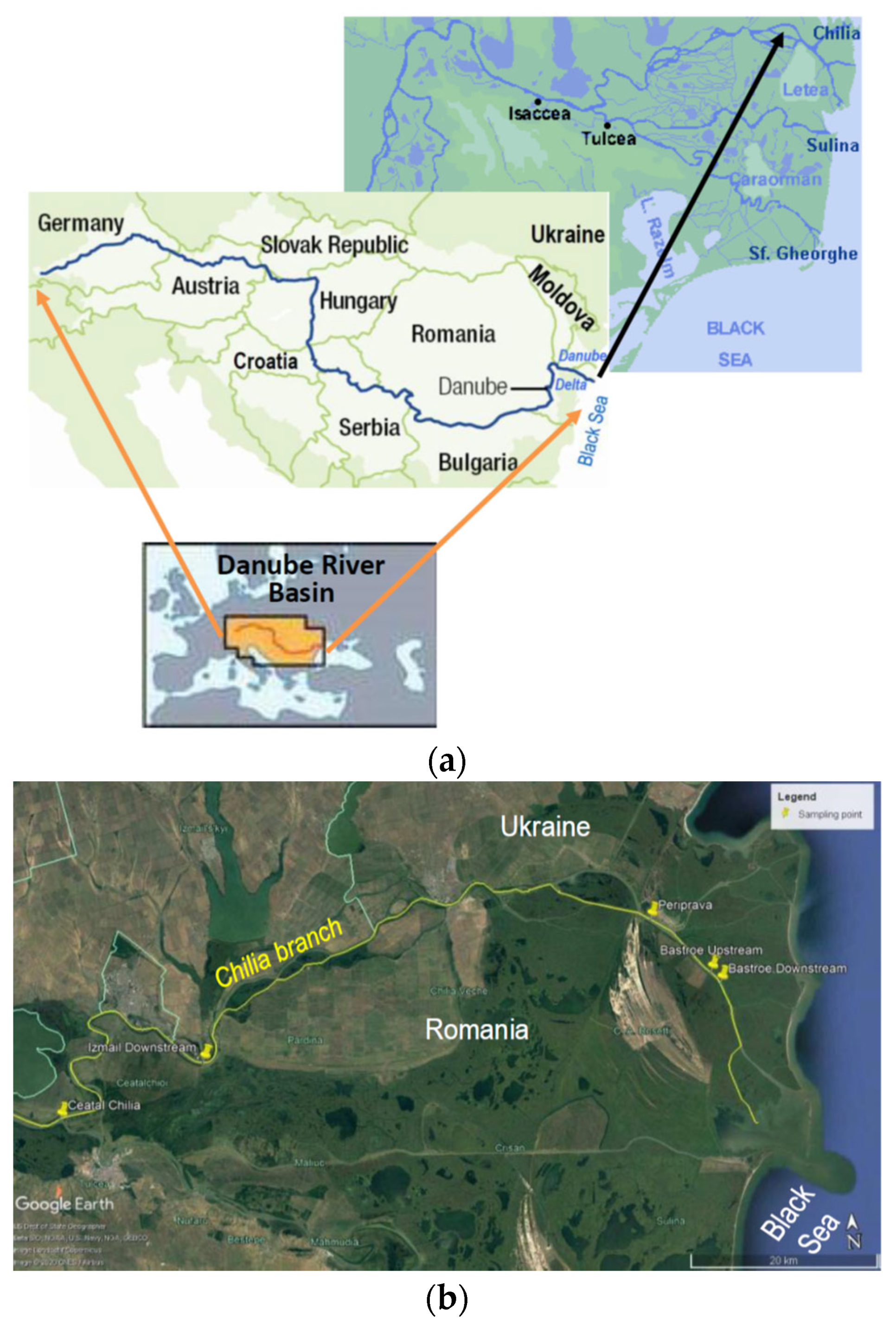
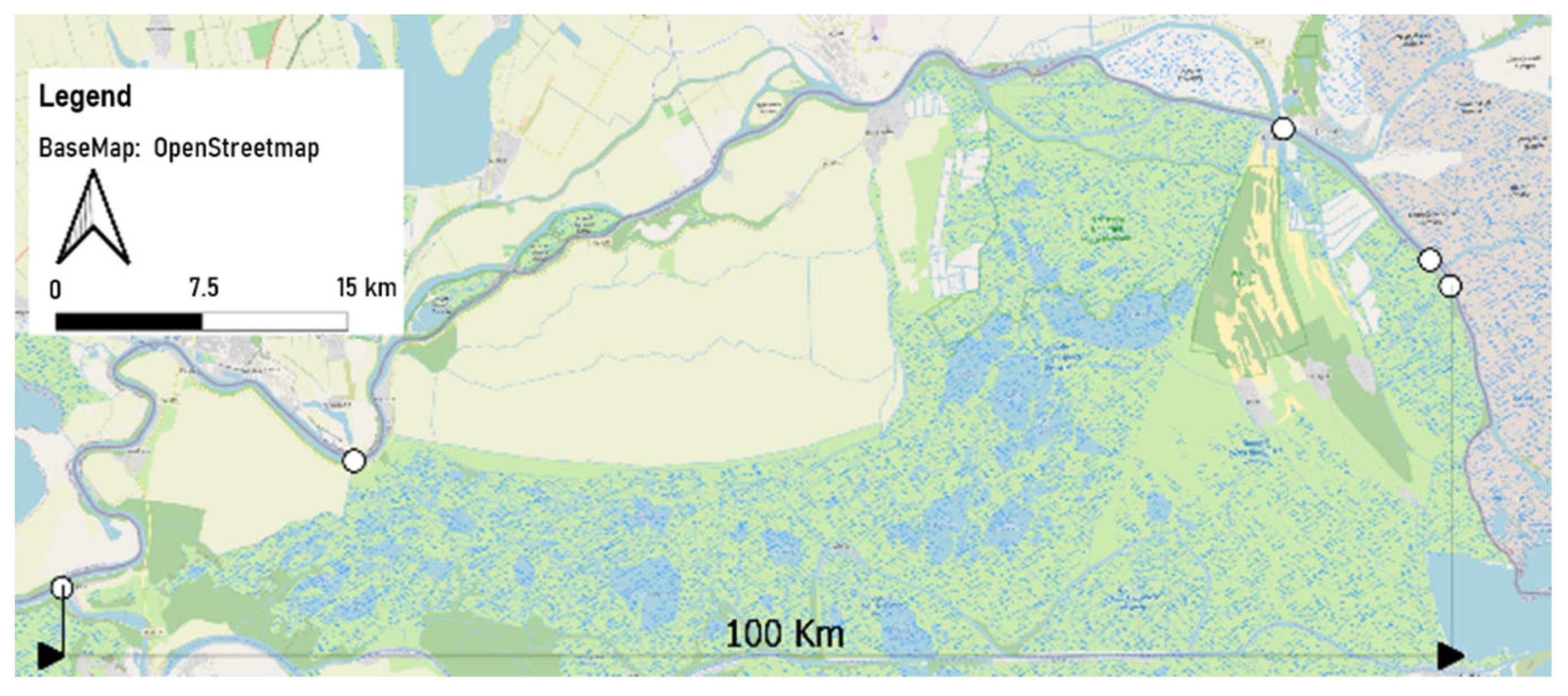
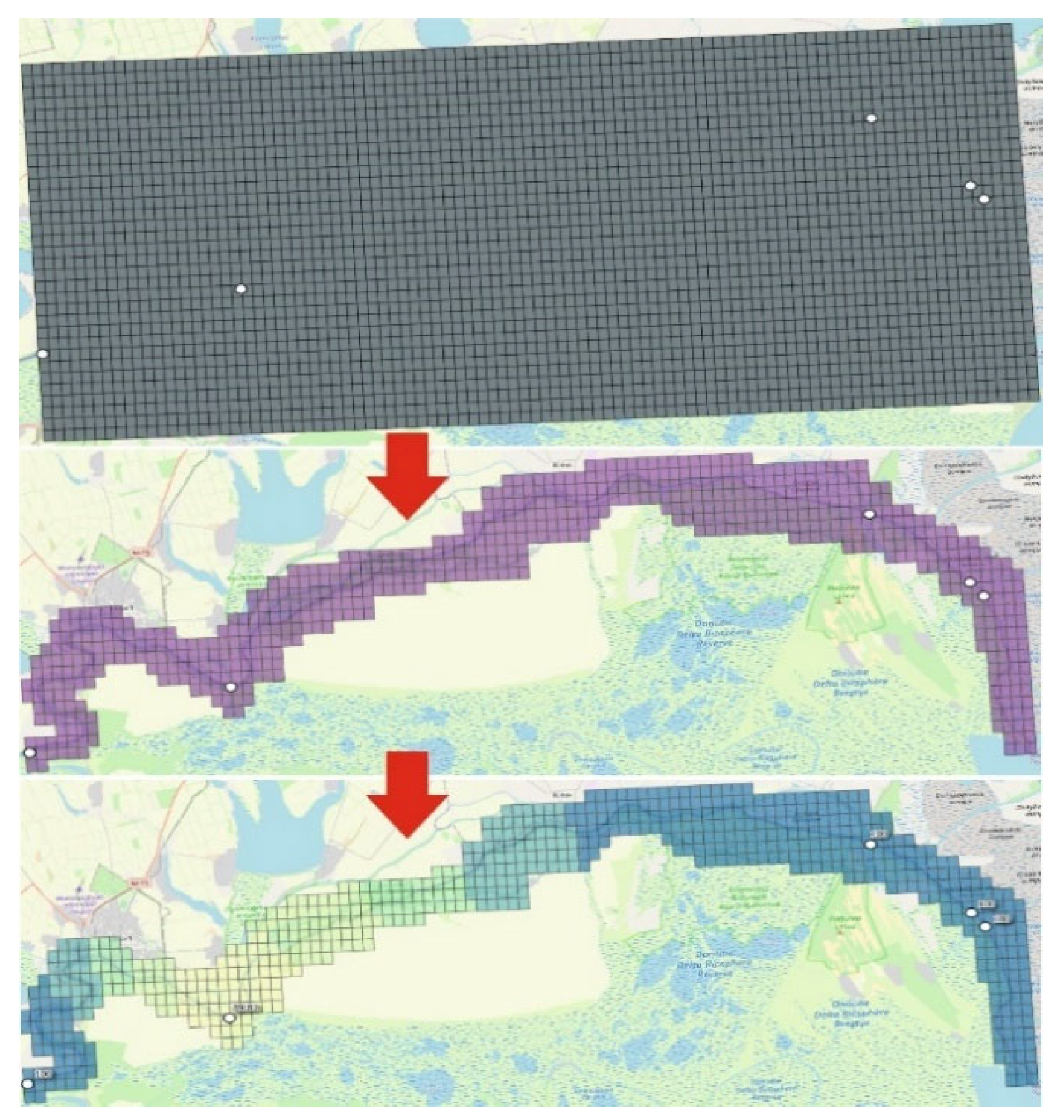
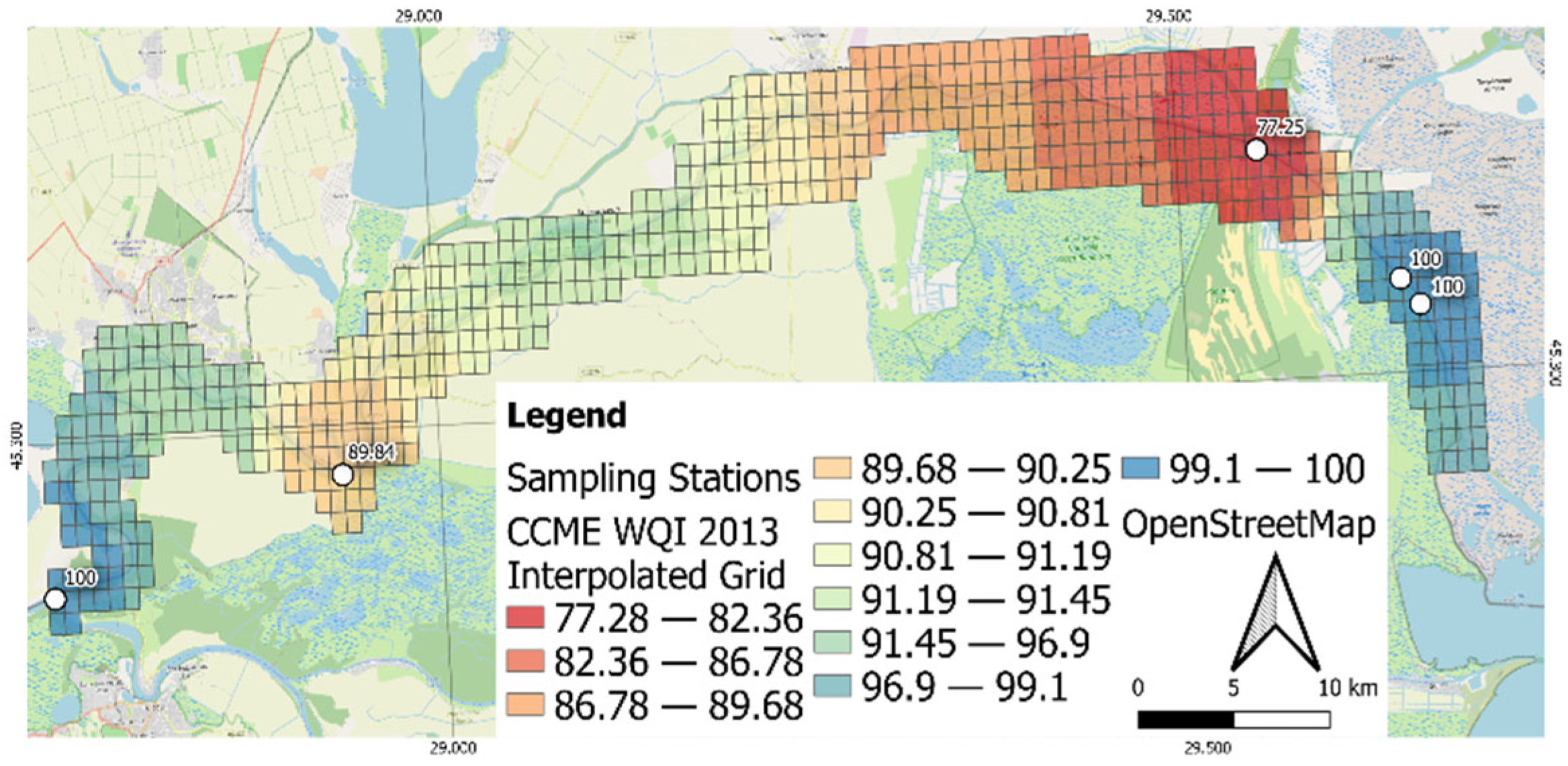
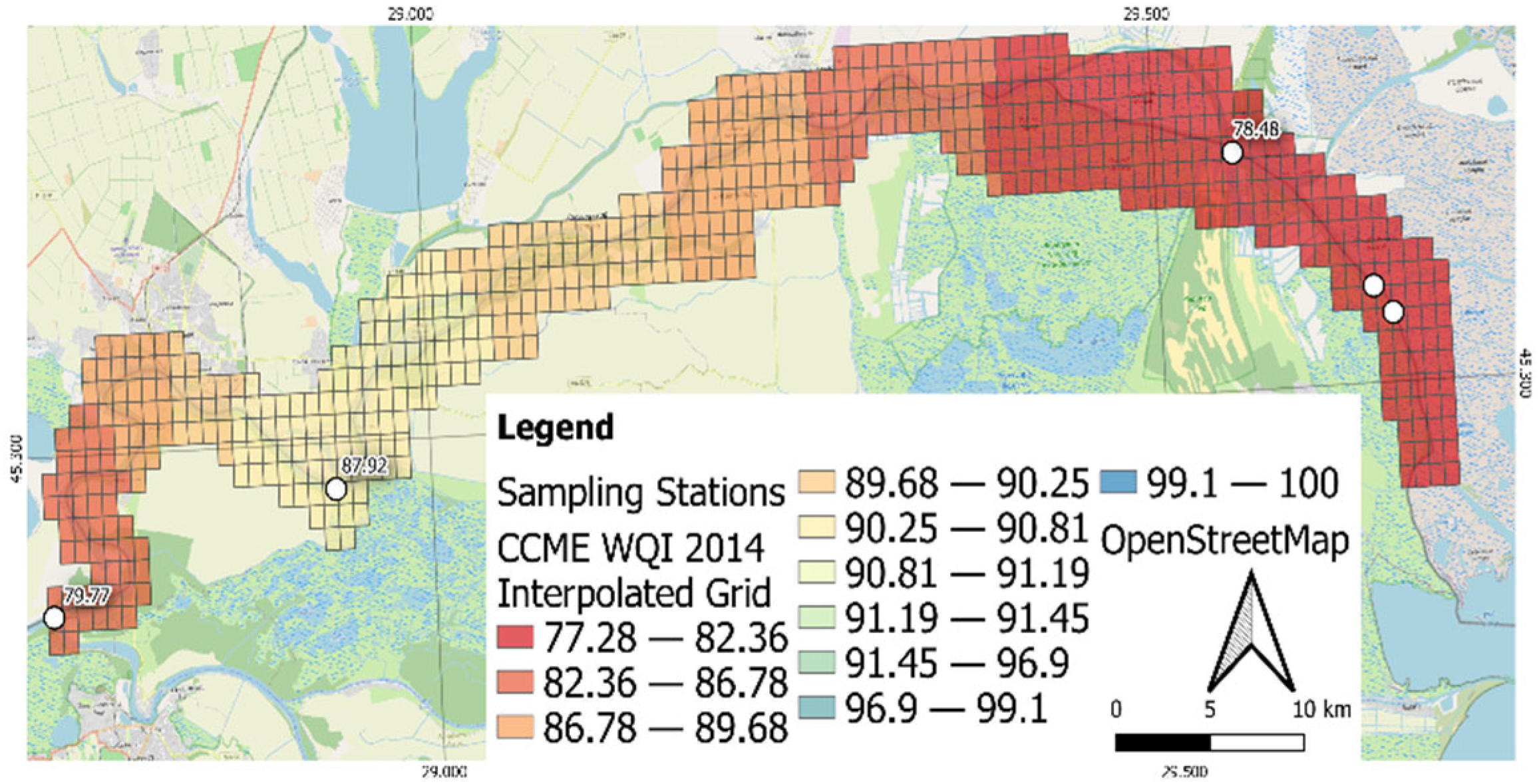
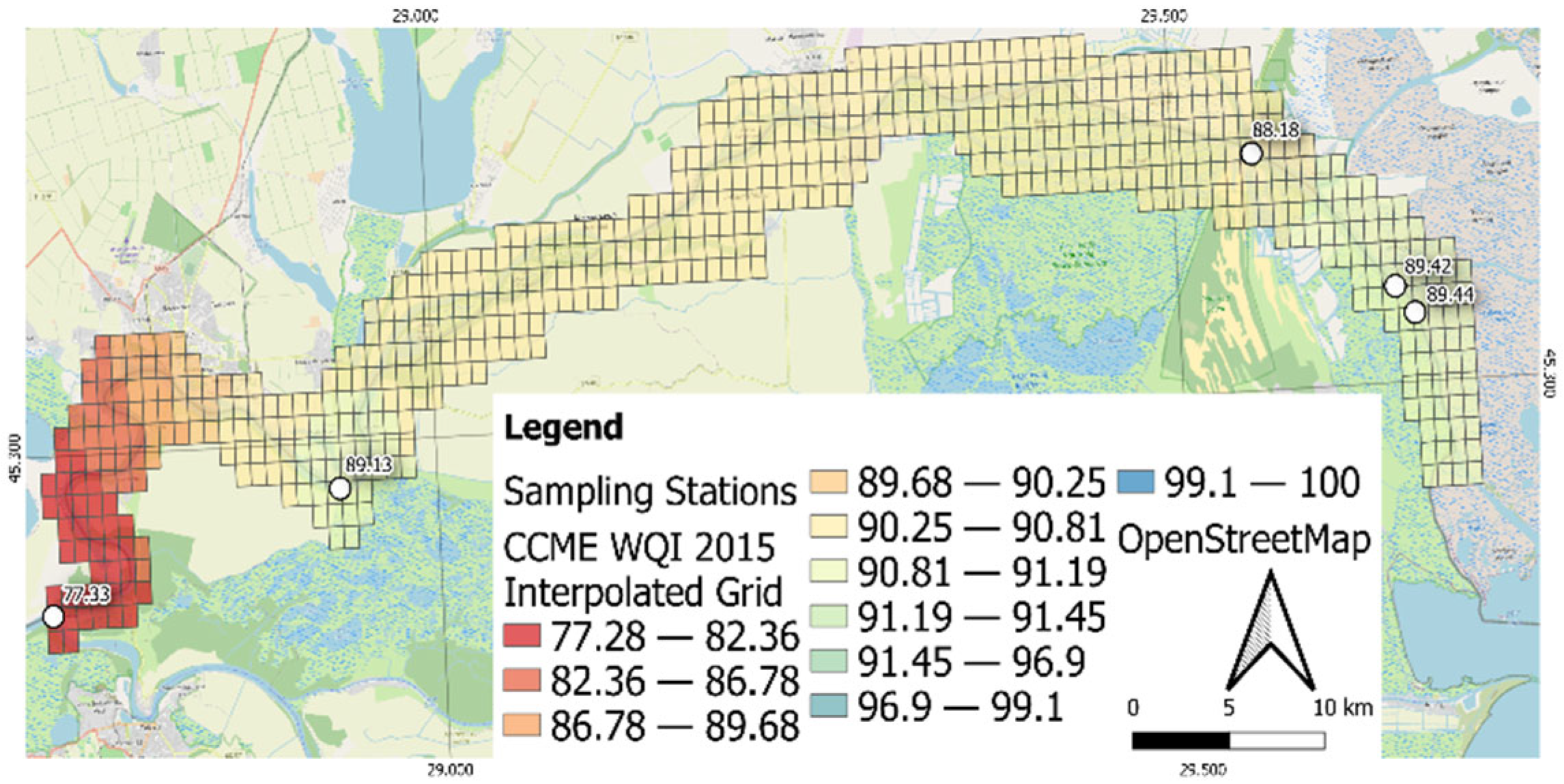
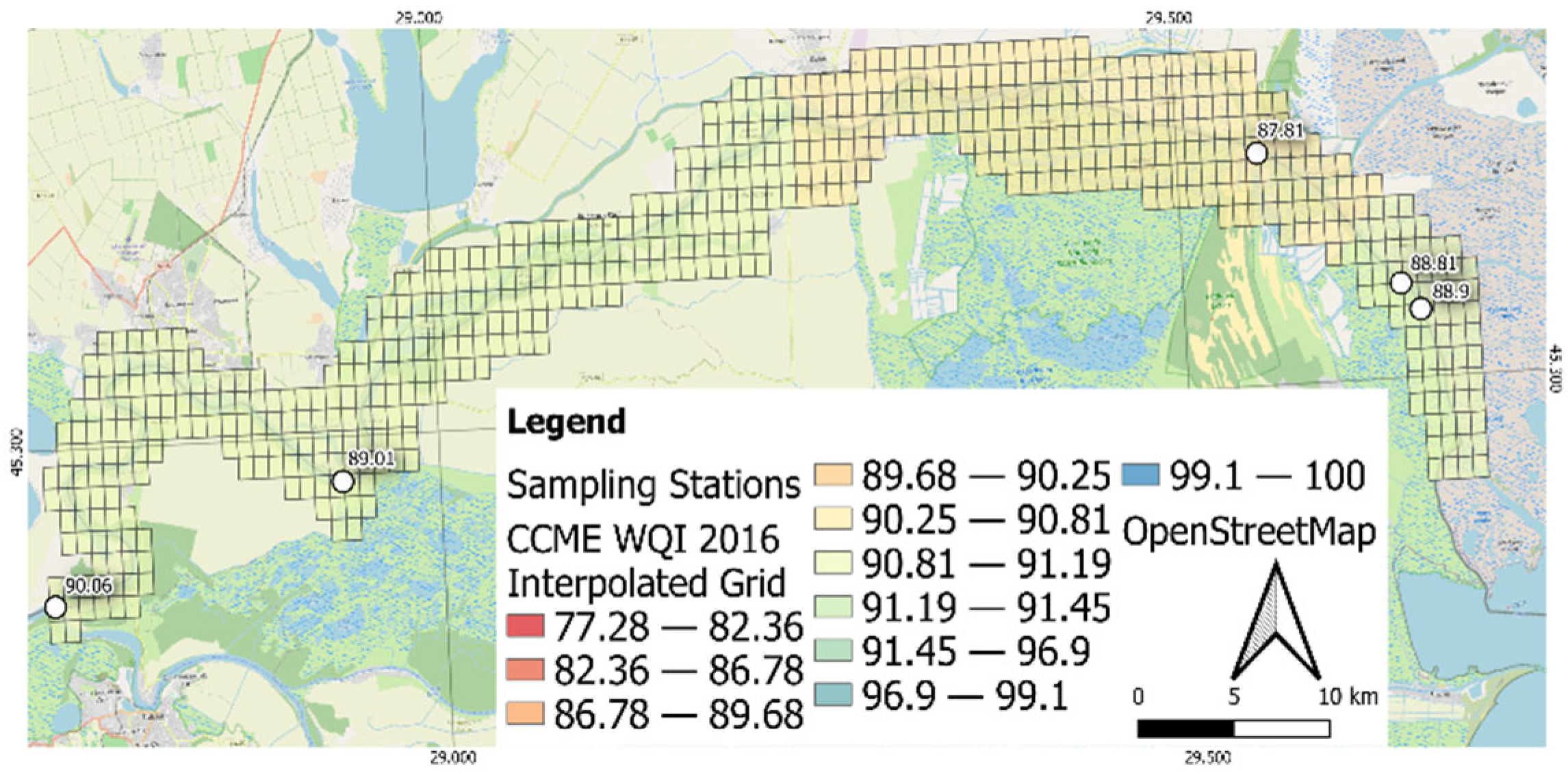
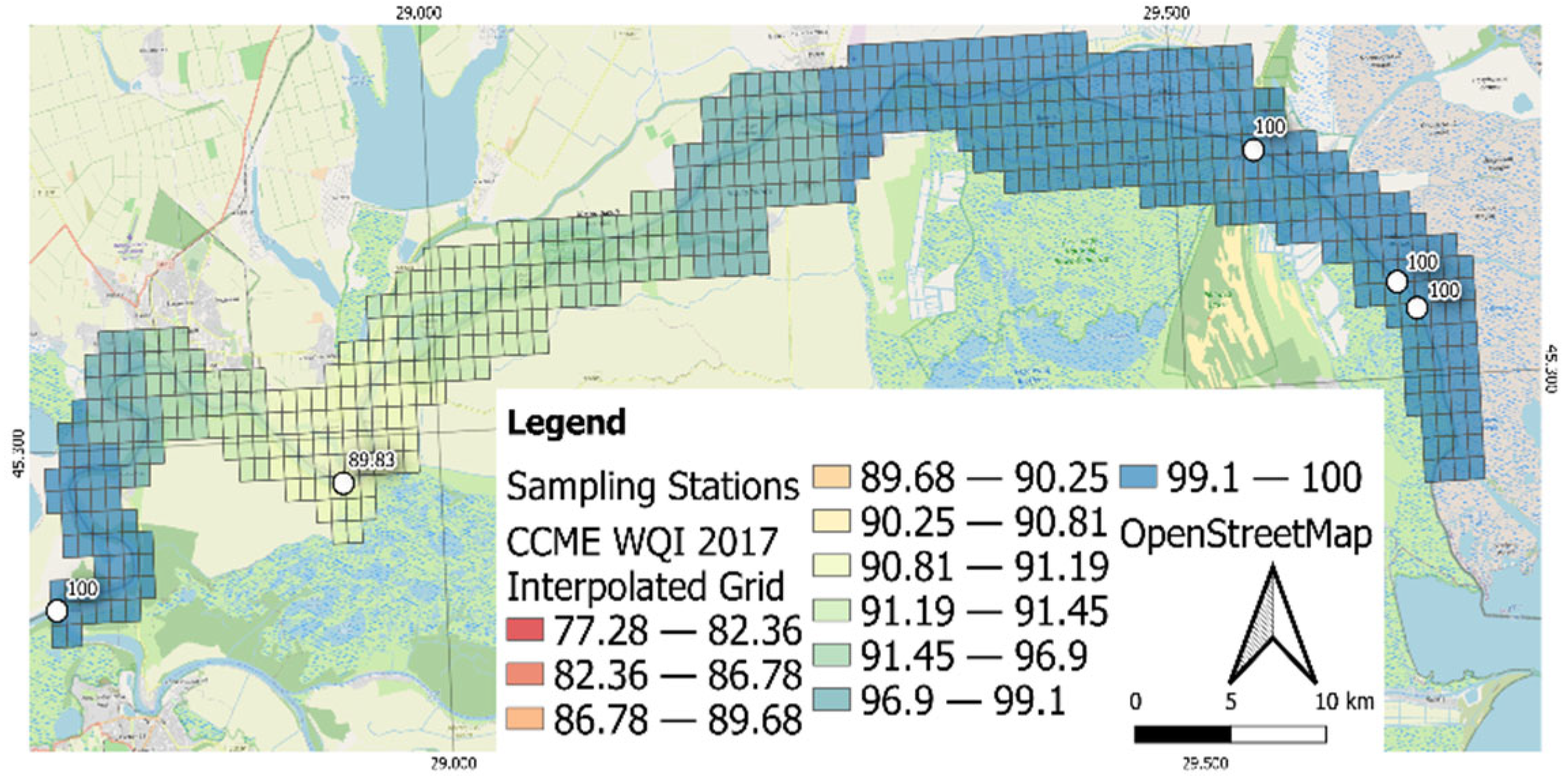
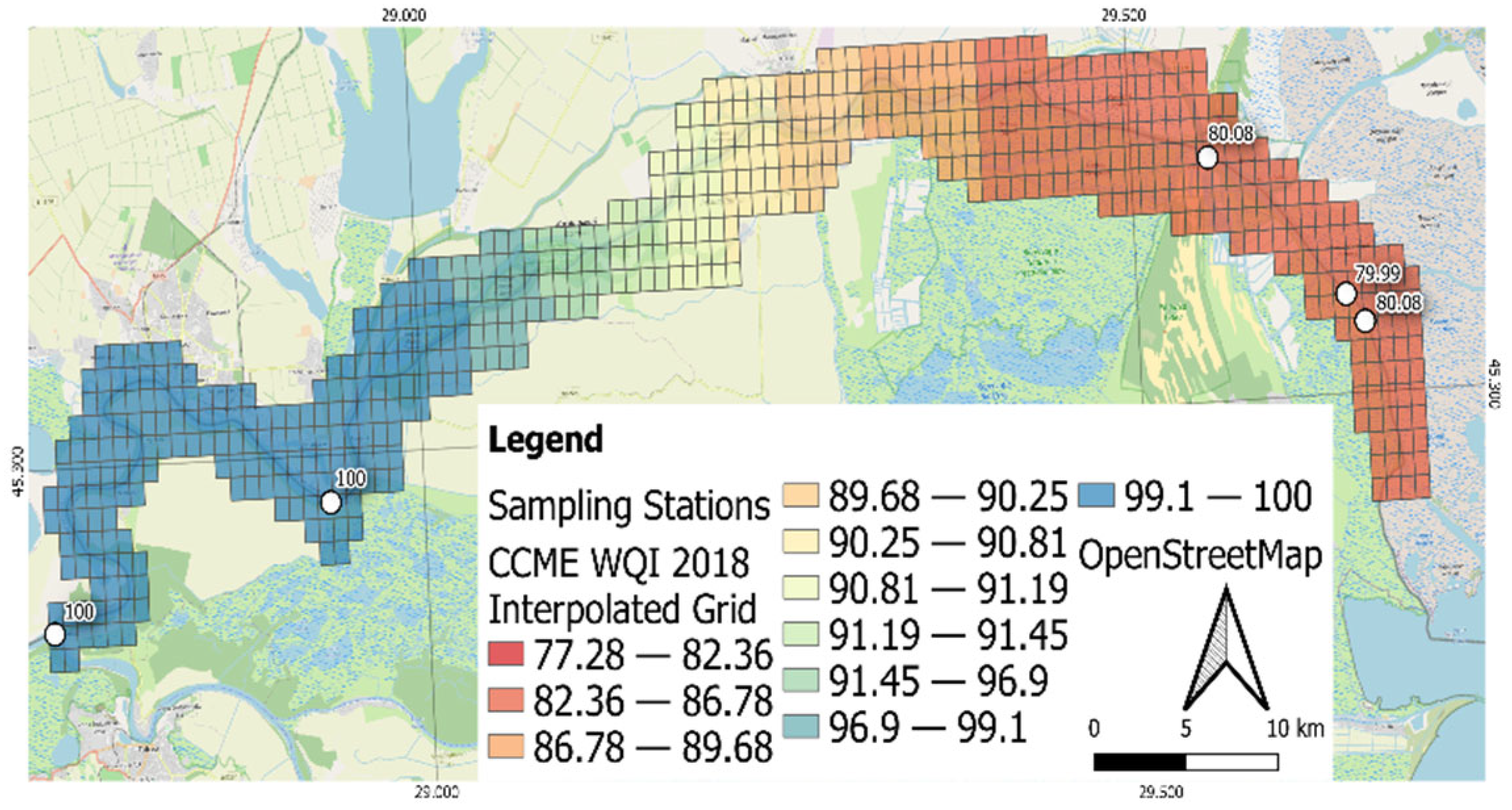

| Sampling Point | Label | Geographical Coordinates | |
|---|---|---|---|
| N | E | ||
| Ceatal Chilia | CC | 45°13.716′ | 28°44.157′ |
| Izmail Downstream | ID | 45°16.793′ | 28°56.137′ |
| Periprava | P | 45°24.051′ | 29°33.867′ |
| Bastroe Upstream | BU | 45°20.659′ | 29°38.600′ |
| Bastroe Downstream | BD | 45°19.975′ | 29°39.337′ |
| Nutrient | Parameters | |||
|---|---|---|---|---|
| Detection Limit [mg/L] | Quantification Limit [mg/L] | Standard Limit [mg/L] | Analysis Standard | |
| Ammonium nitrogen (N-NH4+) | 0.028 | 0.090 | 0.80 | SR ISO 7150–1: 2001 |
| Nitrite nitrogen (N-NO2−) | 0.0007 | 0.0024 | 0.03 | SR EN 26777: 2002 |
| Nitrate nitrogen (N-NO3−) | 0.006 | 0.021 | 3.00 | SR ISO 7890–3: 2000 |
| Total nitrogen (TN) | 0.030 | 0.0110 | 7.00 | SR EN ISO 11905-1:2003 |
| Orthophosphate (P-PO4−3) | 0.002 | 0.010 | 0.20 | SR EN ISO 6878: 2005 |
| Total phosphorus (TP) | 0.003 | 0.010 | 0.40 | SR EN ISO 6878: 2005 |
| Factor/Index | Explanation | ||
|---|---|---|---|
| Brief Description | Formula | ||
| F1 (Scope) | Assesses the extent of water quality guideline non-compliance over the time of interest; it is expressed by the percentage of variables (chemical indicators) that do not meet the water quality standards („failed variables”) | F1 = (Number of failed variables/Total number of variables) * 100 | |
| F2 (Frequency) | Assesses the frequency by which the objectives are not met; it is expressed by the percentage of individual tests that do not meet the quality standards („failed tests”) | F2 = (Number of failed tests/Total number of tests) * 100 | |
| F3 (Amplitude) | Assesses the amount by which the objectives are not met; it is calculated by an asymptotic function that scales the normalized sum of excursions from objectives (nse) to yield a range between 0 and 100 | F3 = nse/(0.01 * nse + 0.01) | |
| excursion | Represents the relative deviation of a failed test from the guideline | excursioni = (Failed test value i/ Objective i) − 1 | |
| nse | Represents the collective amount by which individual tests do not reach the standards (are out of compliance) | nse = (∑ excursioni)/number of tests | |
| CCME WQI | Combines three measures of variance (scope, frequency and amplitude) of excursions from objectives to produce a single unitless number representing the overall water quality at a site relative to the benchmark chosen | CCME WQI = 100 − [√(F12 + F22 + F32)/1.732] (1) | |
| Quality Class | CCME WQI |
|---|---|
| Values | |
| Excellent | 95 ≤ CCME WQI ≤ 100 |
| Good | 80 ≤ CCME WQI < 95 |
| Fair | 65 ≤ CCME WQI < 80 |
| Marginal | 45 ≤ CCME WQI < 65 |
| Poor | 0 ≤ CCME WQI < 45 |
| Parameter | Sampling Point Code | Values | |||||||
|---|---|---|---|---|---|---|---|---|---|
| No. of Samples | Min. | Max. | Median | Mean | Std. dev. | Skewness | Kurtosis | ||
| N-NH4+ | CC | 26 | 0.000 | 0.218 | 0.104 | 0.111 | 0.060 | 0.183 | −0.944 |
| ID | 21 | 0.040 | 0.333 | 0.133 | 0.140 | 0.073 | 0.654 | 0.134 | |
| P | 25 | 0.024 | 0.294 | 0.156 | 0.157 | 0.068 | 0.127 | −0.428 | |
| BU | 17 | 0.038 | 0.227 | 0.141 | 0.137 | 0.058 | −0.111 | −0.974 | |
| BD | 17 | 0.045 | 0.279 | 0.180 | 0.169 | 0.060 | −0.603 | −0.132 | |
| N-NO2− | CC | 26 | 0.008 | 0.054 | 0.018 | 0.020 | 0.010 | 1.594 | 2.709 |
| ID | 21 | 0.008 | 0.037 | 0.018 | 0.020 | 0.008 | 0.945 | −0.059 | |
| P | 25 | 0.009 | 0.122 | 0.020 | 0.026 | 0.023 | 3.077 | 9.609 | |
| BU | 17 | 0.005 | 0.041 | 0.016 | 0.018 | 0.008 | 1.250 | 1.991 | |
| BD | 17 | 0.009 | 0.039 | 0.017 | 0.018 | 0.007 | 1.501 | 1.929 | |
| N-NO3− | CC | 26 | 0.406 | 9.744 | 1.072 | 1.461 | 1.725 | 4.239 | 17.485 |
| ID | 21 | 0.008 | 2.260 | 1.101 | 1.106 | 0.585 | 0.135 | −0.268 | |
| P | 25 | 0.377 | 5.133 | 1.071 | 1.302 | 0.932 | 2.764 | 8.657 | |
| BU | 17 | 0.090 | 2.276 | 1.113 | 1.137 | 0.549 | 0.347 | −0.068 | |
| BD | 17 | 0.403 | 2.436 | 1.010 | 1.185 | 0.580 | 0.943 | −0.213 | |
| TN | CC | 26 | 1.395 | 18.054 | 3.892 | 4.962 | 3.680 | 2.365 | 5.227 |
| ID | 21 | 0.979 | 10.399 | 4.125 | 4.866 | 2.390 | 0.675 | −0.279 | |
| P | 25 | 1.732 | 31.857 | 6.095 | 7.302 | 6.110 | 2.503 | 7.642 | |
| BU | 17 | 2.138 | 13.956 | 5.111 | 6.254 | 3.767 | 0.863 | −0.623 | |
| BD | 17 | 1.935 | 13.735 | 6.688 | 6.731 | 3.305 | 0.579 | −0.281 | |
| P-PO4−3 | CC | 26 | 0.003 | 0.118 | 0.050 | 0.050 | 0.021 | 0.498 | 3.032 |
| ID | 21 | 0.007 | 0.108 | 0.050 | 0.051 | 0.021 | 0.516 | 1.050 | |
| P | 25 | 0.001 | 0.080 | 0.051 | 0.049 | 0.016 | −0.877 | 1.591 | |
| BU | 17 | 0.035 | 0.096 | 0.048 | 0.053 | 0.015 | 1.236 | 1.508 | |
| BD | 17 | 0.031 | 0.067 | 0.045 | 0.048 | 0.010 | 0.285 | −0.825 | |
| TP | CC | 26 | 0.067 | 0.243 | 0.118 | 0.123 | 0.042 | 1.524 | 2.449 |
| ID | 21 | 0.045 | 0.192 | 0.108 | 0.114 | 0.038 | 0.424 | −0.530 | |
| P | 25 | 0.043 | 0.205 | 0.106 | 0.113 | 0.038 | 0.588 | 0.037 | |
| BU | 17 | 0.052 | 0.197 | 0.110 | 0.111 | 0.046 | 0.480 | −1.005 | |
| BD | 17 | 0.050 | 0.217 | 0.122 | 0.122 | 0.051 | 0.315 | −0.878 | |
| Sampling Point | Variables | Values | ||||||
|---|---|---|---|---|---|---|---|---|
| 2013 | 2014 | 2015 | 2016 | 2017 | 2018 | 2019 | ||
| Ceatal Chilia | F1 | 0.00 | 33.33 | 33.33 | 16.67 | 0.00 | 0.00 | 0.00 |
| F2 | 0.00 | 9.52 | 11.11 | 4.17 | 0.00 | 0.00 | 0.00 | |
| nse | 0.00 | 0.05 | 0.21 | 0.01 | 0.00 | 0.00 | 0.00 | |
| F3 | 0.00 | 5.14 | 17.53 | 1.20 | 0.00 | 0.00 | 0.00 | |
| CCME WQI | 100.00 | 79.77 | 77.33 | 90.06 | 100.00 | 100.00 | 100.00 | |
| Izmail Downstream | F1 | 16.67 | 16.67 | 16.67 | 16.67 | 16.67 | 0.00 | 16.67 |
| F2 | 5.56 | 12.50 | 8.33 | 8.33 | 5.56 | 0.00 | 5.56 | |
| nse | 0.01 | 0.02 | 0.03 | 0.04 | 0.01 | 0.00 | 0.02 | |
| F3 | 0.99 | 1.91 | 2.64 | 3.89 | 1.28 | 0.00 | 1.64 | |
| CCME WQI | 89.84 | 87.92 | 89.13 | 89.01 | 89.83 | 100.00 | 89.81 | |
| Periprava | F1 | 33.33 | 33.33 | 16.67 | 16.67 | 0.00 | 33.33 | 0.00 |
| F2 | 11.11 | 13.89 | 11.11 | 12.50 | 0.00 | 8.33 | 0.00 | |
| nse | 0.22 | 0.10 | 0.04 | 0.04 | 0.00 | 0.03 | 0.00 | |
| F3 | 17.84 | 9.21 | 4.22 | 3.41 | 0.00 | 3.14 | 0.00 | |
| CCME WQI | 77.25 | 78.48 | 88.18 | 87.81 | 100.00 | 80.08 | 100.00 | |
| Bastroe Upstream | F1 | 0.00 | - | 16.67 | 16.67 | 0.00 | 33.33 | 0.00 |
| F2 | 0.00 | - | 5.56 | 8.33 | 0.00 | 8.33 | 0.00 | |
| nse | 0.00 | - | 0.06 | 0.06 | 0.00 | 0.05 | 0.00 | |
| F3 | 0.00 | - | 5.23 | 5.35 | 0.00 | 4.52 | 0.00 | |
| CCME WQI | 100.00 | - | 89.42 | 88.81 | 100.00 | 79.99 | 100.00 | |
| Bastroe Downstream | F1 | 0.00 | - | 16.67 | 16.67 | 0.00 | 33.33 | 0.00 |
| F2 | 0.00 | - | 5.56 | 8.33 | 0.00 | 8.33 | 0.00 | |
| nse | 0.00 | - | 0.05 | 0.05 | 0.00 | 0.03 | 0.00 | |
| F3 | 0.00 | - | 5.07 | 4.74 | 0.00 | 3.10 | 0.00 | |
| CCME WQI | 100.00 | - | 89.44 | 88.90 | 100.00 | 80.08 | 100.00 | |
| Quality Class | WQI |
|---|---|
| Values | |
| Very good | WQI < 25 |
| Good | 25 ≤ WQI < 50 |
| Moderate | 50 ≤ WQI < 75 |
| Bad | 75 ≤ WQI < 100 |
| Very bad | 100 ≤ WQI |
| Sampling Point | Index | 2013 | 2014 | 2015 | 2016 | 2017 | 2018 | 2019 |
|---|---|---|---|---|---|---|---|---|
| Ceatal Chilia | WQI | 42.849 | 74.704 | 46.550 | 56.795 | 51.788 | 63.718 | 54.225 |
| Izmail Downstream | 45.347 | 79.950 | 40.583 | 42.969 | 61.304 | 61.786 | 70.651 | |
| Periprava | 46.879 | 147.394 | 40.758 | 51.019 | 61.304 | 59.633 | 60.133 | |
| Bastroe Upstream | 44.948 | 44.935 | 57.134 | 45.760 | 58.715 | 60.704 | ||
| Bastroe Downstream | 42.616 | 43.536 | 56.242 | 45.760 | 64.128 | 60.113 | ||
| Ceatal Chilia | CCME WQI | 100.00 | 79.77 | 77.33 | 90.06 | 100.00 | 100.00 | 100.00 |
| Izmail Downstream | 89.84 | 87.92 | 89.13 | 89.01 | 89.83 | 100.00 | 89.81 | |
| Periprava | 77.25 | 78.48 | 88.18 | 87.81 | 100.00 | 80.08 | 100.00 | |
| Bastroe Upstream | 100.00 | 89.42 | 88.81 | 100.00 | 79.99 | 100.00 | ||
| Bastroe Downstream | 100.00 | 89.44 | 88.90 | 100.00 | 80.08 | 100.00 |
Publisher’s Note: MDPI stays neutral with regard to jurisdictional claims in published maps and institutional affiliations. |
© 2021 by the authors. Licensee MDPI, Basel, Switzerland. This article is an open access article distributed under the terms and conditions of the Creative Commons Attribution (CC BY) license (https://creativecommons.org/licenses/by/4.0/).
Share and Cite
Teodorof, L.; Ene, A.; Burada, A.; Despina, C.; Seceleanu-Odor, D.; Trifanov, C.; Ibram, O.; Bratfanof, E.; Tudor, M.-I.; Tudor, M.; et al. Integrated Assessment of Surface Water Quality in Danube River Chilia Branch. Appl. Sci. 2021, 11, 9172. https://doi.org/10.3390/app11199172
Teodorof L, Ene A, Burada A, Despina C, Seceleanu-Odor D, Trifanov C, Ibram O, Bratfanof E, Tudor M-I, Tudor M, et al. Integrated Assessment of Surface Water Quality in Danube River Chilia Branch. Applied Sciences. 2021; 11(19):9172. https://doi.org/10.3390/app11199172
Chicago/Turabian StyleTeodorof, Liliana, Antoaneta Ene, Adrian Burada, Cristina Despina, Daniela Seceleanu-Odor, Cristian Trifanov, Orhan Ibram, Edward Bratfanof, Mihaela-Iuliana Tudor, Marian Tudor, and et al. 2021. "Integrated Assessment of Surface Water Quality in Danube River Chilia Branch" Applied Sciences 11, no. 19: 9172. https://doi.org/10.3390/app11199172
APA StyleTeodorof, L., Ene, A., Burada, A., Despina, C., Seceleanu-Odor, D., Trifanov, C., Ibram, O., Bratfanof, E., Tudor, M.-I., Tudor, M., Cernisencu, I., Georgescu, L. P., & Iticescu, C. (2021). Integrated Assessment of Surface Water Quality in Danube River Chilia Branch. Applied Sciences, 11(19), 9172. https://doi.org/10.3390/app11199172









